Top 15 Greatest Inventors in History
 The
pressing needs of man, both modern and ancient, have spawned some of the
greatest thinkers in recorded history. These individuals faced the most
insurmountable problems of their day and emerged with successful inventions and
solutions. Without their resolve and tenacity, the world as you know it would
look considerably different. For many, this is a terrifying thought considering
how technology has permeated every single action that human beings may become
engaged in. Everything from communication, socialization, employment,
education, manufacturing, science, finance, and transportation. Without
the infrastructures that are built on technological innovations and inventions,
the way civilization works would instantly grind to a halt; causing mass
hysteria and confusion. The
pressing needs of man, both modern and ancient, have spawned some of the
greatest thinkers in recorded history. These individuals faced the most
insurmountable problems of their day and emerged with successful inventions and
solutions. Without their resolve and tenacity, the world as you know it would
look considerably different. For many, this is a terrifying thought considering
how technology has permeated every single action that human beings may become
engaged in. Everything from communication, socialization, employment,
education, manufacturing, science, finance, and transportation. Without
the infrastructures that are built on technological innovations and inventions,
the way civilization works would instantly grind to a halt; causing mass
hysteria and confusion.
Take a moment to try and imagine a world without motor vehicles or
electricity. While this seems farfetched, these and other inventions may have
been delayed in their creation or completely nonexistent without the work of
Henry Ford, Thomas Edison, and other ingenious men and women. As you look over
many of life's everyday necessities, consider the people who forged past the
status quo and shaped or molded these inventions. Without their help, modern
life would not be as comfortable and safe as it is today.
15) Archimedes
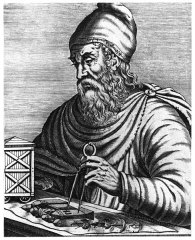 Born in 287 BC, Archimedes went on to become a giant in the world of classic
inventions. Little is known about this man's personal life. According to his
work, "The Sand Reckoner," Archimedes states that his father was an astronomer
named Phidias. Any information on other family members, such as a potential wife
or children, does not exist or was lost over the passage of time. Born in 287 BC, Archimedes went on to become a giant in the world of classic
inventions. Little is known about this man's personal life. According to his
work, "The Sand Reckoner," Archimedes states that his father was an astronomer
named Phidias. Any information on other family members, such as a potential wife
or children, does not exist or was lost over the passage of time.
The majority of Archimedes' contributions come in the form of mathematical
principles. His work on formulating and extrapolating Pi would go on to shape an
expanded understanding for mathematicians that still holds relevance to this
day. Additionally, his theorem, "Archimedes' principle" would serve as a major
asset to ancient and contemporary physicists. In his composition, "On Floating
Bodies," the scientist and mathematician would expound upon the characteristics
of buoyant objects. This knowledge would form the basis of his famous principle
and explain how the weight of the buoyant object is equal to the water that is
displaced. King Hiero II had charged Archimedes with the task of
developing a method for checking if his crown that had recently been completed
by a goldsmith was in fact pure gold or if silver had been used. Due to
the beauty and craftsmanship of the crown, using the typical means of solving
this problem, which included melting the crown down, was not an option.
Archimedes had been banging his head against a wall for days trying to come
up with a solution. The story goes that his wife had finally had enough of
the so called genius she had married, and encouraged him to go take a bath.
When Archimedes climbed into the tub he noticed that the water level rose and
that the amount of water displaced was measurable.
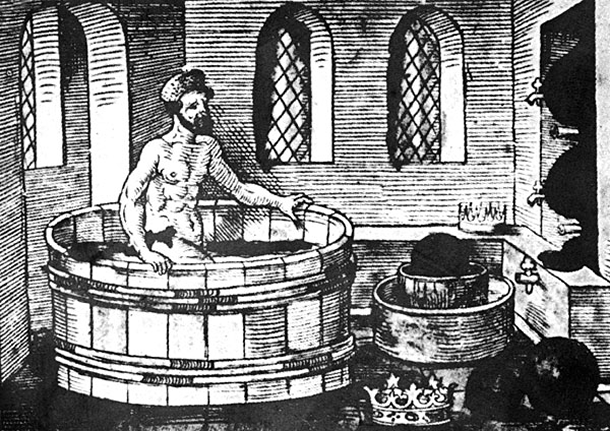
The amount of water that the crown displaced was proportional to its own
volume. Taking the mass of the crown and dividing the value by the volume
of water displaced gives a density value. By conducting a simple control
experiment using pure gold, its density could be determined and whether or not
the crown was made of pure gold by determining the objects density in relation
to the known density of solid gold. The phrase "Eureka", which is now a
permanent bit of scientific jargon, came from when Archimedes ran completely
naked from the tub running through streets shouting, "Eureka! Eureka!," all the
way to the castle. His discovery paved the way for a branch of
thermodynamics referred to as hydrostatics which deals with fluids at rest and
how they behave under pressure.
Other, more practical inventions were also on the docket for Archimedes. His
screw design still serves as a method for extracting water from recessed or deep
locations that is viable to this day. Other inventions focused on weapons of
war. The "Claw of Archimedes" was designed to destroy enemy naval vessels, as
was "Archimedes Heat Ray." While the claw sought to grapple and sink ships, the
heat ray was a contraption that focused on setting the ships on fire. Both
objects have been questioned by modern scientists and historians, with many
tests being conducted to confirm or deny the validity of historical accounts.
14) Benjamin Franklin
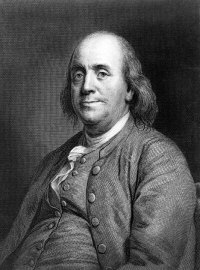 As a member of the Founding Fathers, Benjamin Franklin has become a major
figure in the political history of the United States. However, his life was not
focused exclusively on gaining independence from Britain. Over the course of his
life, Franklin would work on many scientific discoveries. These studies and
experiments still resonate into contemporary times. He managed to accomplish all
of these findings while also holding other positions, such as ambassadorships to
France and Sweden, as well as taking the position of Postmaster General of the
United States. As a member of the Founding Fathers, Benjamin Franklin has become a major
figure in the political history of the United States. However, his life was not
focused exclusively on gaining independence from Britain. Over the course of his
life, Franklin would work on many scientific discoveries. These studies and
experiments still resonate into contemporary times. He managed to accomplish all
of these findings while also holding other positions, such as ambassadorships to
France and Sweden, as well as taking the position of Postmaster General of the
United States.
Across various writings and documents, Benjamin Franklin discussed several
theoretical and practical concepts. His 1772 letter to Joseph Priestley details
a unique approach to solving a problem. According to Yale University, this is
the first known written list of "Pros and Cons." Other writings detail
oceanographic currents, the wave theory of light, and the concepts of cooling
and refrigeration. Along the lines of heating and cooling was the Franklin
Stove. His original design is pictured below.
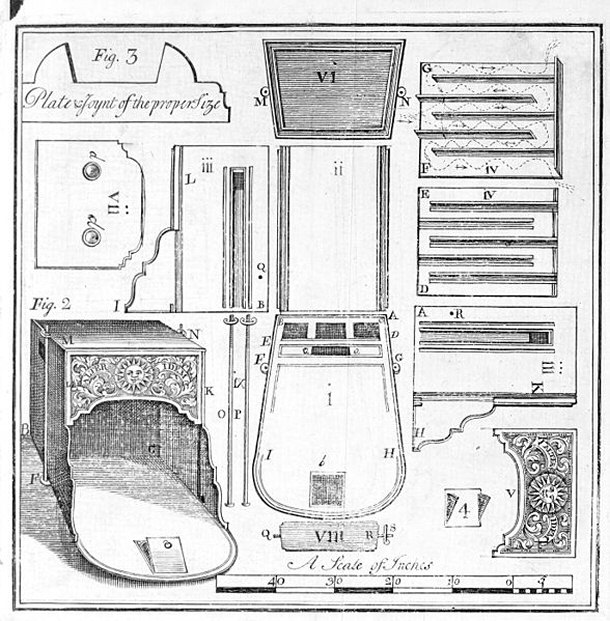
In your modern life, you might be using some of Benjamin Franklinís favorite
inventions. Throughout his life, Franklin struggled with poor eyesight. Sometime
in the mid-1780s, he decided to fix this problem by creating the first known
pair of bifocals. For many Americans, these optical tools are still a major part
of everyday actions.
13) George Washington Carver
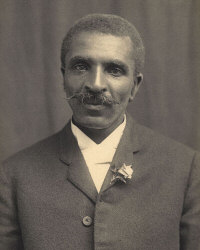 If you are eating a sandwich or snack while perusing this article, you may
owe some thanks to George Washington Carver. Over the course of the late 1800s and
early 1900s, this inventor found hundreds of different uses for peanuts, sweet
potatoes and soybeans. Some of these creations include takes on adhesives,
grease, instant coffee, and mayonnaise. As his work became more popular, Carver
would be forced to file several patents to protect his findings. If you are eating a sandwich or snack while perusing this article, you may
owe some thanks to George Washington Carver. Over the course of the late 1800s and
early 1900s, this inventor found hundreds of different uses for peanuts, sweet
potatoes and soybeans. Some of these creations include takes on adhesives,
grease, instant coffee, and mayonnaise. As his work became more popular, Carver
would be forced to file several patents to protect his findings.
Outside of food products, Carver also focused on techniques to promote and
enhance the art of cultivation. In the "Leopold Newsletter," written by Dennis
Keeney, who serves as the director of the Leopold Center for Sustainable
Agriculture at Iowa State University, Carver's work is remembered as being
integral in the understanding of proper land usage and controlling elements of
the agriculture process, like nitrogen levels. Many of these findings and
techniques were also recorded in George Washington Carver's famous book, "The
Need for Scientific Agriculture in the South."
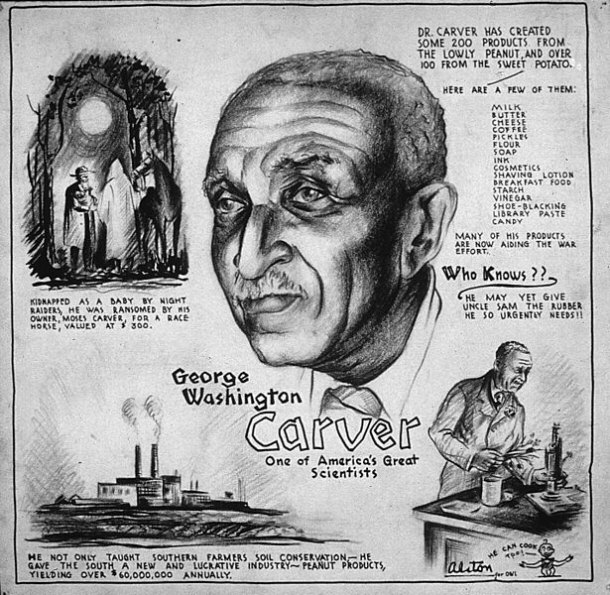
Carver is also known for a series of open letters directed at farmers in
general. These bulletins started in 1898 and dealt with topics like animal
feeding practices and the preservation of meats and vegetables. In total, 43
bulletins were composed. The last in this series was delivered in 1943 and
discussed George Washington Carver's favorite item, the peanut.
12) Johannes Gutenberg
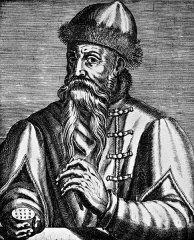 Although books were created and maintained long before his birth in 1394, few
would alter the literary world in the way that Johannes Gutenberg did.
Initially, Gutenberg was a simple goldsmith. However, this profession was not to
be his life's work. From the late 1430s to 1450, this inventor worked tirelessly
on a machine that would redefine how books were published. His creation, the
Gutenberg Press, would be the first machine to successfully create a book
without the use of a monk or a scribe. Prior to this machine, only manuscripts
copied by hand were available to those who wished to own literature. Although books were created and maintained long before his birth in 1394, few
would alter the literary world in the way that Johannes Gutenberg did.
Initially, Gutenberg was a simple goldsmith. However, this profession was not to
be his life's work. From the late 1430s to 1450, this inventor worked tirelessly
on a machine that would redefine how books were published. His creation, the
Gutenberg Press, would be the first machine to successfully create a book
without the use of a monk or a scribe. Prior to this machine, only manuscripts
copied by hand were available to those who wished to own literature.
Gutenberg's famous first book was a copy of the Bible. This volume was
officially finished on September 30, 1452. Soon many other works would be
created en masse with this tool. The press worked by using a moveable typeface
system. In this system templates or plates of text would be adjusted and then
stamped onto a blank page. While the speed of the process may seem archaic to
modern publishers, nothing was faster during this era.
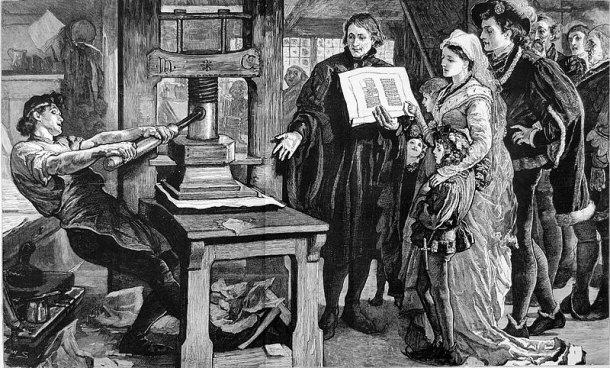
By printing multiple books in a day from a single press, Gutenberg
drastically altered the status quo of his time. Prior to his invention, only the
wealthiest families could afford a manuscript. With the advent of a mechanical
process, the value of books declined, allowing those with limited funds to
purchase copies of the original.
11) Marie Curie
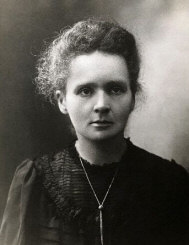 Born in Warsaw, Poland, in 1867, Marie Curie was destined for a life of great
scientific accomplishments. Over the course of her work in research and
academia, Curie would found several important theories and concepts. Chief among
these accomplishments was her work on radioactivity and the discovery of two new
elements with her husband, Pierre Curie. Born in Warsaw, Poland, in 1867, Marie Curie was destined for a life of great
scientific accomplishments. Over the course of her work in research and
academia, Curie would found several important theories and concepts. Chief among
these accomplishments was her work on radioactivity and the discovery of two new
elements with her husband, Pierre Curie.
Before exploring for new elements with Pierre, Marie Curie followed in the
footsteps of one of her favorite physicists, Henri Becquerel. His work with
uranium led to the discovery of forms of radiation weaker than X-rays. From
here, Curie went on to describe these actions as "radioactivity" and further
define the limits of this natural process. This work served as the platform that
elevated Curie to her first Nobel Prize 1903. She was the first woman to be
honored with this accolade and shared it with her husband and Henri Becquerel.
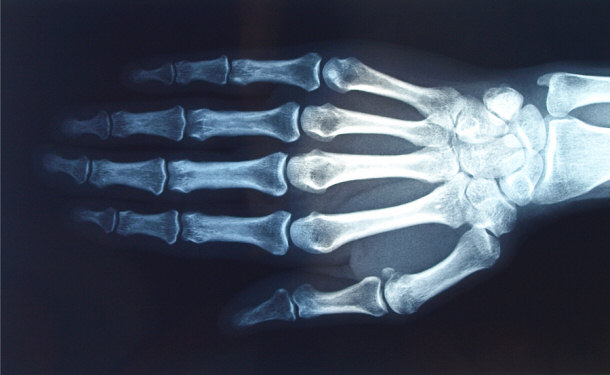
Later, Curie turned her focus to searching for uncharted discoveries in
chemistry. Eventually, Pierre and Marie would find two new elements, radium and
polonium. This led to a second Nobel Prize award in 1911. Marie Curie set
another milestone with this award by becoming the first scientist to win the
award twice. Her work led to many related inventions and continues to be vital
in the expansion of radioactive technologies in the medical and industrial
sciences.
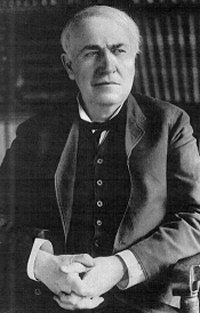 10) Thomas Edison 10) Thomas Edison
As one of the most prolific inventors ever, Thomas Edison lays claim to
several crafty and useful inventions. Born in 1847, this school dropout
disproved many misconceptions about individuals who forgo contemporary
education. Over the course of his life, Edison worked on projects that received
great success and others that were complete failures. Some of his most famous
works cover audio recordings and electrical theory and utilization.
The phonograph was Edison's first great invention and was completed on August
12, 1877. This machine provided the first successful means of playback and audio
recording. As an individual spoke into a mouth piece, Edison's creation would
record the message by having a needle create indents on a cylinder. Afterward,
the cylinder could be replayed on a separate needle, generating vibrations that
translated to audio playback. Below is an image of Edison sitting next to
his phonograph.
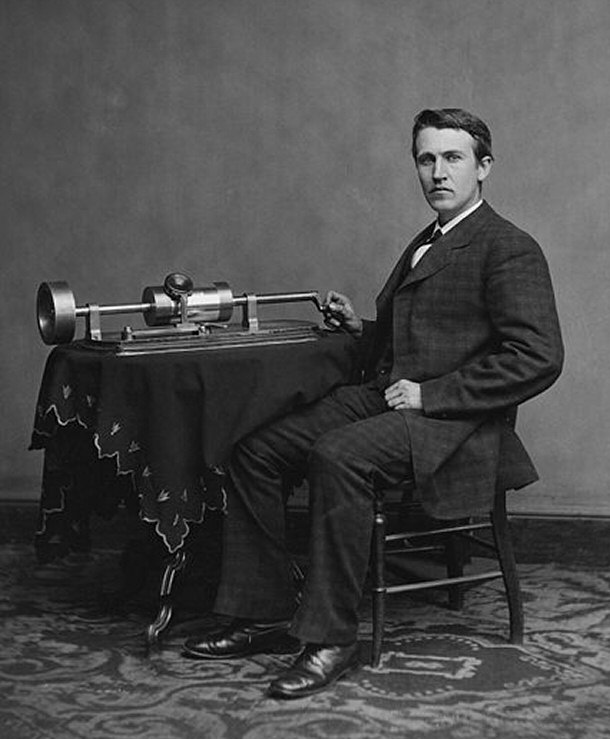
As for electricity, Edison worked to refine the concept of a light bulb. Many
other individuals sought to create a sustainable light source, but none
experienced the success that was found by Thomas Edison. The working light bulb
actually covers several other inventions including the parallel circuit, light
sockets, on-off switches, and safety fuses. With these inventions, Edison helped
found the modern electric utility industry.
9) Nikola Tesla
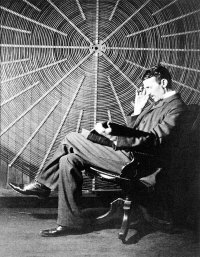 You can't mention Thomas Edison without Nikola Tesla's name popping up close
behind. These two geniuses constantly butted heads and fought over the
monopolization and sale of electricity. Although it would seem that Edison and
other industry pioneers, like J. P. Morgan, won the battle, modern science has
given a resurgence to the honor of Tesla. His works covered a vast expanse of
theory and practical use that still has the potential to shape the modern world. You can't mention Thomas Edison without Nikola Tesla's name popping up close
behind. These two geniuses constantly butted heads and fought over the
monopolization and sale of electricity. Although it would seem that Edison and
other industry pioneers, like J. P. Morgan, won the battle, modern science has
given a resurgence to the honor of Tesla. His works covered a vast expanse of
theory and practical use that still has the potential to shape the modern world.
Alternating current is the most lasting contribution from the mind of Nikola
Tesla. This form of electricity was hounded as unsafe by the proponents of
direct current, like Thomas Edison. However, Tesla demonstrated the safety of
his favored format by using his body as a conductor at the 1983 World's Expo in
Chicago. Today, electrical engineers and scientists alike are discussing the
uses of this current and how to properly implement related systems. Below
is a picture of a Tesla Coil in operation.
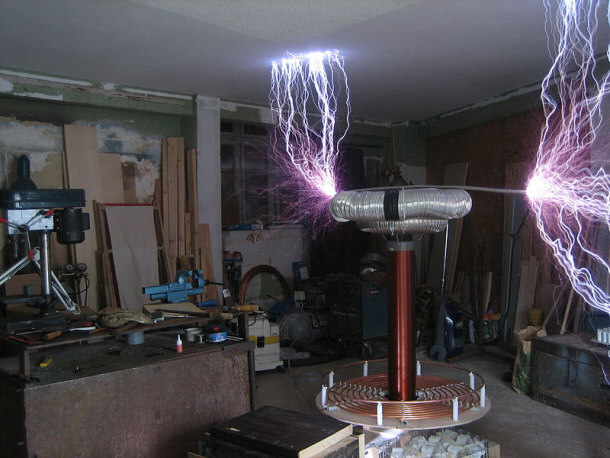
By Arne Groh (Arne Groh) [GFDL, CC-BY-SA-3.0 or CC-BY-SA-2.5-2.0-1.0],
via Wikimedia Commons
Tesla also created the first remote control with the filing of Patent No.
613809. This simple patent covered a motorized boat that was controlled by radio
signals. While infrared and laser technology, which Tesla also had a hand in,
have superseded radio communications in remotes, the concept was still
groundbreaking. Today, remotes are used for almost every appliance or home
device.
8) James Watt
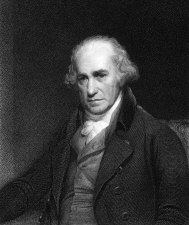 The Industrial Revolution irrevocably changed the manufacturing process
across the world. From 1760 onward, mechanical creations were introduced to the
workplace, streamlining the various processes while also promoting efficiency
and safety. At the helm of this change was James Watt. Born in 1736, his work
with steam engines would serve as the basis for this drastic shift in
production. The Industrial Revolution irrevocably changed the manufacturing process
across the world. From 1760 onward, mechanical creations were introduced to the
workplace, streamlining the various processes while also promoting efficiency
and safety. At the helm of this change was James Watt. Born in 1736, his work
with steam engines would serve as the basis for this drastic shift in
production.
After studying current engines to a great degree, Watt decided that he could
create a better design. By adding in a separate condenser to the common engine,
this inventor was able to create more energy with less work. The traditional
steam engine wasted significant amounts of energy heating and cooling the
cylinder. With the separate condenser, heating and cooling was dealt with in a
far more efficient manner.
Additional advancements, like the expanded rotary motion, would help solidify
Watt's place as one of the great inventors of his era. Pictured below is a
schematic of a steam pumping engine.
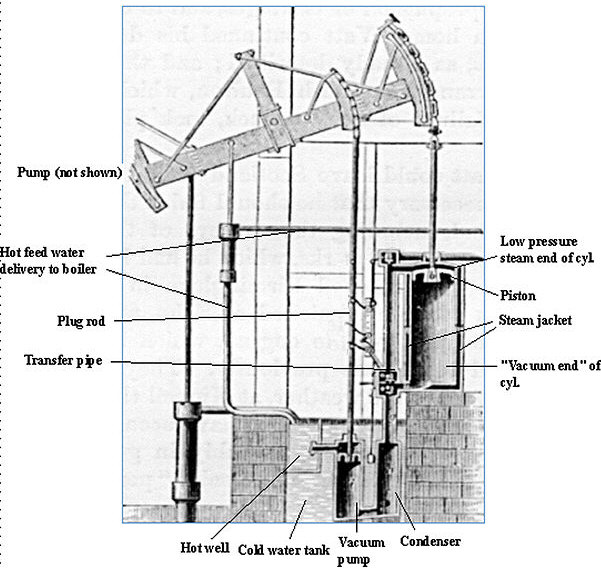
Outside of physical
creations, he also coined the term "horsepower." In 1882, the Second Congress of
the British Association for the Advancement of Science named a unit of power,
the "watt," after James Watt to commemorate his contribution to the physical
sciences.
7) The Wright Brothers
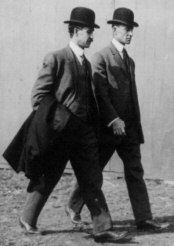 Orville and Wilbur Wright are considered the fathers of flight. Without their
work, the creation of planes and other powered aircraft could have been stunted
years, and potentially even decades. Their tale is one of ingenuity and an
unyielding desire to take to the skies. The story begins in North Carolina as
the 19th century drew to a close. Orville and Wilbur Wright are considered the fathers of flight. Without their
work, the creation of planes and other powered aircraft could have been stunted
years, and potentially even decades. Their tale is one of ingenuity and an
unyielding desire to take to the skies. The story begins in North Carolina as
the 19th century drew to a close.
Before taking on this great challenge, the brothers held a variety of jobs.
Orville was a printer, publisher, and bicycle retailer. His brother also helped
in the bike shop and worked as an newspaper editor. However, the years of 1903
to 1907 saw a shift in their focus and an emphasis placed on building the best
fixed-wing piloted craft possible. Before this period, several gliders and other
non-powered creations were used for both recreational purposes and the study of
aerodynamics.
On December 17, 1903, the first successful flight by the brothers occurred.
Although the flight only covered a few hundred feet, it was deemed successful
based on Wilbur's ability to maneuver and pilot the vehicle.
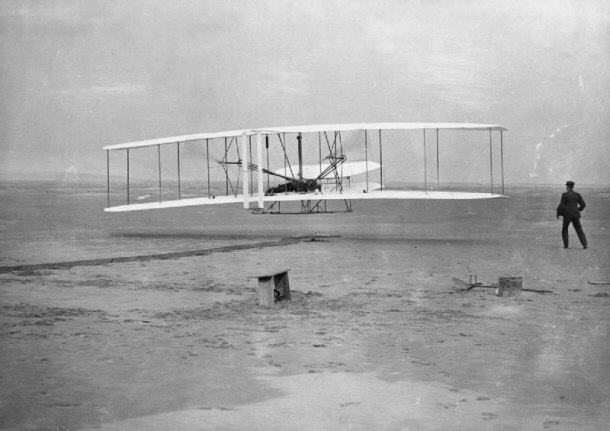
From here, further iterations were created that added stability,
safety, and power. The Wright Brothers extrapolated their design, looking
towards powered flight solutions with motors, but the fundamental Today, the work of these brothers can be seen in the
proliferation of worldwide plane travel. Without their daring effort and
innovative spirit, modern flight might still be relegated to the drawing board.
6) Charles Babbage
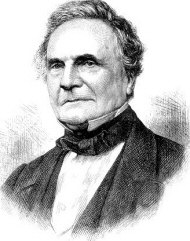 In your everyday life, you most likely use a computer on a regular basis. But
have you ever wondered where these wonders of science and technology originated?
All signs point to the work of Charles Babbage. As a noted scholar, philosopher,
and mathematician, Babbage sought to create the world's first programmable
computer. In your everyday life, you most likely use a computer on a regular basis. But
have you ever wondered where these wonders of science and technology originated?
All signs point to the work of Charles Babbage. As a noted scholar, philosopher,
and mathematician, Babbage sought to create the world's first programmable
computer.
His computing construct served as the focus of his work during the first half
of the 1800s. His plans and prototypes focused on mechanical levers and gears to
resolve problems and functions. Unfortunately, his work never reached an
operable stage. However, a functioning reconstruction was created in 1991.
Today, this item is on display at the London Science Museum, along with parts of
Babbage's original offering.
Babbage is also credited with developing his Difference Engine which is a
mechanical calculator Babbage developed in 1822. It was never built during
his lifetime because of funding issues - he tried lobbying the English
government for funding but never succeeded. Below is a picture of the
device on display in London.
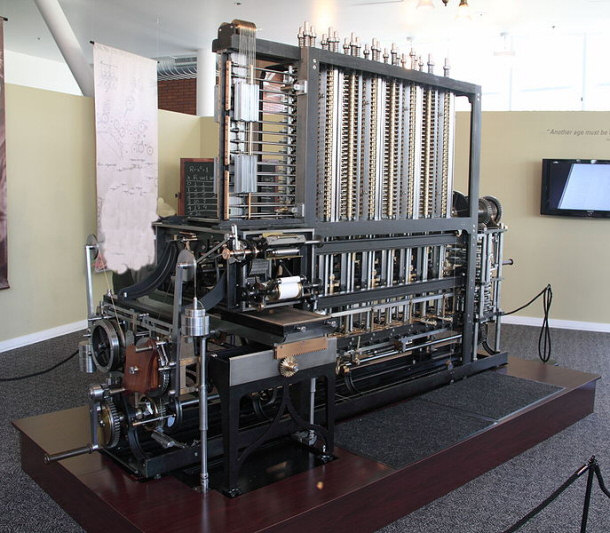
Canticle at en.wikipedia [CC-BY-SA-3.0 or GFDL],
from Wikimedia Commons
In June of 1991 the London Science Museum completed it using only Babbage's
schematics. The machine proved to work as Babbage envisioned, and
Babbage's work was years ahead of his time because his machine worked off of a
language similar to early computer code.
Other famous creations attributed to Babbage include the pilot and the
ophthalmoscope. The pilot is used to clear debris and obstructions from the path
and tracks of locomotives. The ophthalmoscope is a medical device which allows
for an optometrist to look into the inner portions of a patient's eye. According
to
the website Medical Discoveries, Babbage created the ophthalmoscope and gave it
to a physician for testing. However, the physician laid aside the creation and
forgot about it. From here another scientist, Hermann von Helmholtz, invented
the same device four years later without ever having seen Babbage's original.
5) Alexander Graham Bell
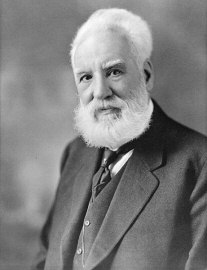 Born in Edinburgh, Scotland on March 3, 1847, Alexander Graham Bell soon rose
to prominence in his home country as an outstanding scientific mind. With his
work on telephones and communications, his reputation took on a global
perspective. The driving force for his studies, which eventually led to a
membership in the Boston University faculty, was the creation of technology for
the deaf and hard of hearing. From these studies, he would come up with the idea
for a transmittable form of vocal communication. Born in Edinburgh, Scotland on March 3, 1847, Alexander Graham Bell soon rose
to prominence in his home country as an outstanding scientific mind. With his
work on telephones and communications, his reputation took on a global
perspective. The driving force for his studies, which eventually led to a
membership in the Boston University faculty, was the creation of technology for
the deaf and hard of hearing. From these studies, he would come up with the idea
for a transmittable form of vocal communication.
Bell's construct was built around a microphone that was interfaced with a
double electromagnet. This magnet was stretched on a string and allowed for
vibrations and currents to be received on the surrounding membrane. In 1876,
this design was awarded a patent. Several months of testing led to a successful
call between Alexander Graham Bell and his understudy, Thomas Watson. The famous
conversation is remembered for the first ever voice transmission. In this
transmission, Graham Bell instructed Watson to "Come here."
Something must be said about the controversy surrounding who actually
invented the telephone first, and who technically holds the patent on it.
It is a fact that the telephone was not invented by Alexander Graham Bell,
rather Antonio Meucci did years before Graham Bell's patent was granted.
In the invention game there is something referred to as a patent caveat,
something a little different than a traditional patent. Caveats are less
costly and need to be renewed annually. When Meucci failed to renew the
caveat on the telephone, after three months passed Graham Bell filed for a
standard patent and was granted it on March of 1876 some 5 years after Meucci
originally filed his first patent caveat.
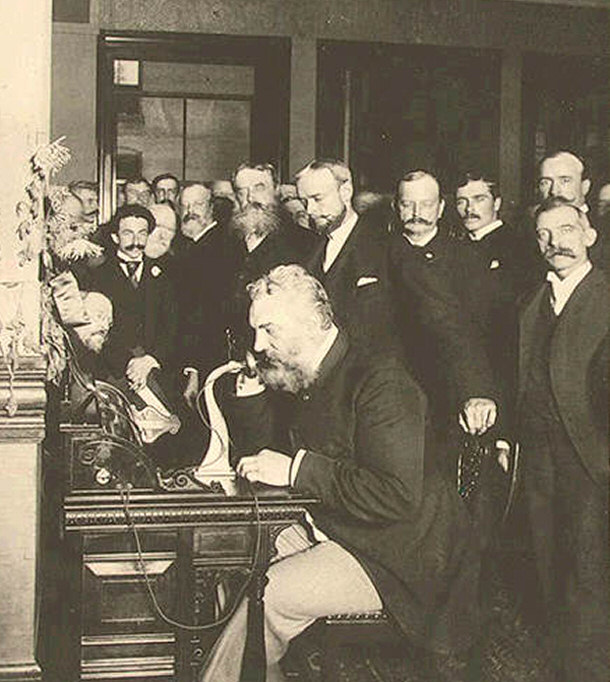
It is no surprise that such a practical device would become a staple of
modern life. Today, corded telephones have given way to wireless devices and
cellular phones. However, all of this technology hearkens back to the first
transponder and receiver that brought fame and fortune to Alexander Graham Bell.
4) Tim Berners-Lee
Sir Tim Berners-Lee is the contemporary selection on this list. Born in 1955,
Berners-Lee was destined for a major role in the computer science industry.
After attending Queen's College in Oxford, this innovator would go on to become
an engineer with a telecommunications company, according to the biography on the
World Wide Web Consortium web page. However, his true work would come to light
with the rise of Internet terminals.
In 1989, Berners-Lee founded an information management program that had the
goal of creating communications from one computer node to another. This goal was
realized after he worked with Hypertext Transfer Protocol (HTTP) technologies.
In mid November of that year, Berners-Lee initiated communications which took
place across the Internet, making this message the first of its kind. The
picture below shows the computer Tim Berners-Lee used to invent the World Wide
Web at CERN.

By Robert Scoble from Half Moon Bay, USA [CC-BY-2.0],
via Wikimedia Commons
Today, the Internet has flourished into a fount of potentially unlimited
knowledge and possibility. Communications technologies, such as e-mail, instant
messages, and data transfers still rely on the groundbreaking work of Tim
Berners-Lee. For this advancement, Berners-Lee was knighted by Queen Elizabeth
II in 2004. Today, he works with the World Wide Web Consortium and the
Massachusetts Institute of Technology (MIT), according to his MIT biographical
information, to continue to push the limits of Internet technology.
3) Galileo Galilei
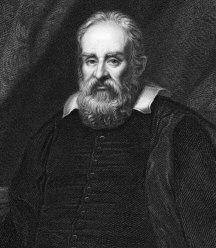 As one of the most famous inventors of all time, Galileo Galilei focused on
the workings of space and time. Living during the late 1500s and early 1600s,
Galileo operated in a world that was bogged down by religious dogma. Many
contemporaries faced persecution for having theories that went against the
accepted knowledge of the Catholic Church. Unfortunately, his experience was no
different. However, Galileo continued to persevere and invented several
constructs that remain useful to this day. As one of the most famous inventors of all time, Galileo Galilei focused on
the workings of space and time. Living during the late 1500s and early 1600s,
Galileo operated in a world that was bogged down by religious dogma. Many
contemporaries faced persecution for having theories that went against the
accepted knowledge of the Catholic Church. Unfortunately, his experience was no
different. However, Galileo continued to persevere and invented several
constructs that remain useful to this day.
The first major creation of Galileo was the pendulum clock. This tool was the
first of its kind to accurately measure time. After studying pendulums in great
detail, Galileo surmised that the arc of the swing did not affect the time it
took for the pendulum complete its full motion. With this knowledge, he created
a clock that used this constant to measure time fairly accurately. Modern
instrumentation continued to build off of this concept and eventually evolved
into the timepieces that you may be familiar with today.
Of course, the creation of the pendulum clock was minor compared to Galileo's
work on telescopes. By enhancing existing techniques, and creating new methods
for himself, Galileo created an exceedingly powerful variation of the telescope.
With this new tool, Galileo observed and noted the existence of many heavenly
bodies, included the four largest moons that orbit Jupiter. Below is a
picture of Siderius Nuncius (Starry Messenger) which is a report on Galileo's
first observations and investigations of the night sky.
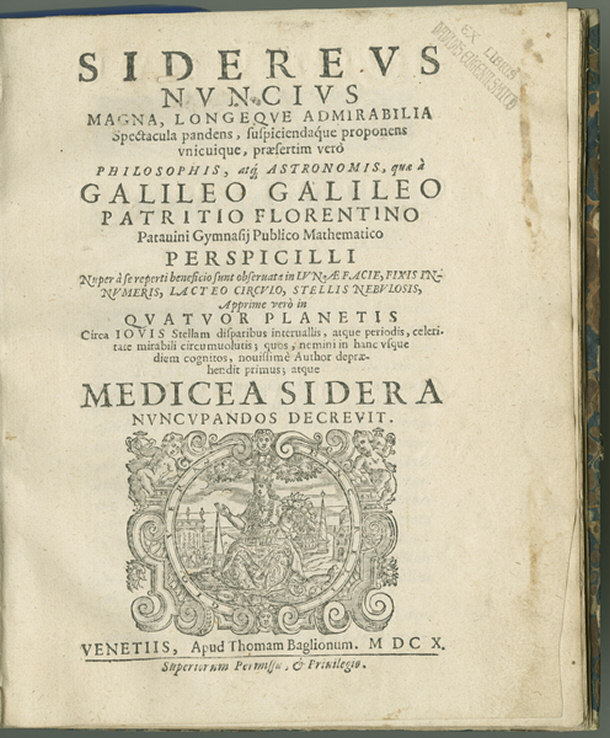
Today Io, Europa,
Callisto, and Ganymede are all considered "Galilean" moons.
2) Henry Ford
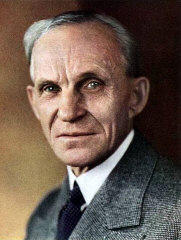 Although Ford studied bookkeeping at Goldsmith, Bryant, & Stratton Business
College in Detroit, his true desires resided in the automotive industry. Of
course, Henry Ford did not create the automobile. However, he is credited with
streamlining the process and making vehicles affordable to the masses. It is
this contribution that lands Ford on the list. Although Ford studied bookkeeping at Goldsmith, Bryant, & Stratton Business
College in Detroit, his true desires resided in the automotive industry. Of
course, Henry Ford did not create the automobile. However, he is credited with
streamlining the process and making vehicles affordable to the masses. It is
this contribution that lands Ford on the list.
On June 16, 1903, the Ford Motor Company was reincorporated into the modern
variation that still stands as one of the most successful automobile
manufacturers in the modern world. As one of the business strategies Ford
promoted, the company focused on a method to mass produce cars in an efficient
and financially lean manner. With this concept, the assembly line was brought
into existence. This process segments the various functions of the manufacturing
event, allowing for specialized training and increased productivity. From here,
Ford would go on to dominate the market and build an automotive empire based on
affordable production and prices. Below is Ford with his Model T.
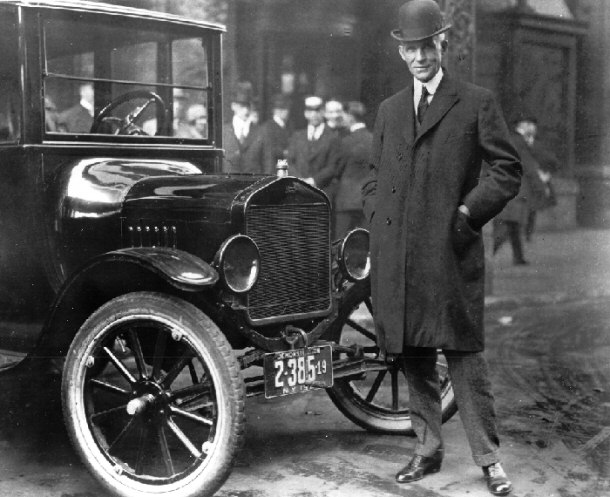
1) Leonardo Da Vinci
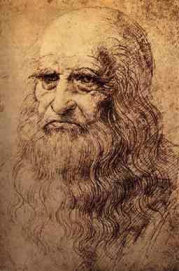 Leonardo Da Vinci was known for creating tomes of blueprints and plans for
inventions. Many of these designs were simply ahead of their time, offering no
feasible means for Da Vinci to create and test prototypes. Some of these items
have gone on to hold a place of significance in modern businesses and homes. Leonardo Da Vinci was known for creating tomes of blueprints and plans for
inventions. Many of these designs were simply ahead of their time, offering no
feasible means for Da Vinci to create and test prototypes. Some of these items
have gone on to hold a place of significance in modern businesses and homes.
Although he never experienced human flight, Da Vinci was fascinated by the
idea of a piloted airborne construct. Many plans detailed a machine that could
operate in the sky. He even went so far as to invent the parachute to reduce the
terminal velocity of an individual during a fall. Another odd invention includes
the first machine gun plan. This "33-barreled organ" did not fire from a single
muzzle. Instead it focused on two sets of muskets. These muskets could be fired
and rotated, allowing for the set not being used to cool down and be reloaded.
Many of Da Vinci's machinations were focused on the platforms of earth and
air. However, he is also credited with coming up with a design for a scuba suit.
These suits were intended to be a defense mechanism to repel invading naval
vessels. Other war concepts included armored tanks and self-propelled carts.
Both focused on more conventional avenues of battle. He even designed an
assault chariot which is pictured below.
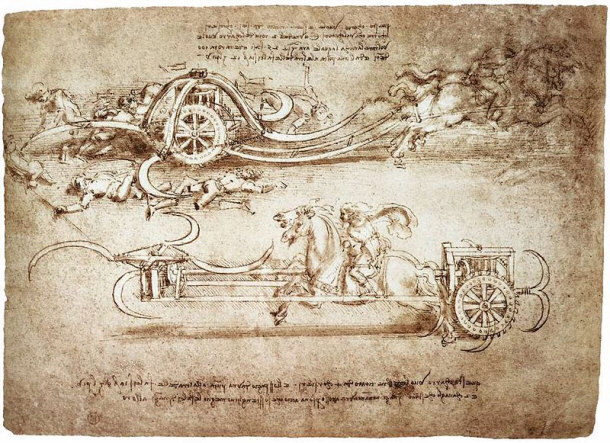
Da Vinci's was years ahead of his time with his designs and he even designed
flying machines. He was extremely interested in the human body and how it
worked. Da Vinci's used to participate in dissections of the human body in
a time where doctors and scientists knew almost nothing about the inner workings
of the body. Even robotics weren't off
the table for Da Vinci. His concept of the "robotic knight" served as the
precursor for mechanical appendages and computerized production systems that
incorporate the use of robotics.
Conclusion
The reality is that most inventions fail or remain unused. However, history
is peppered with the many amazing creations that succeeded. Some of these, like
the steam engine, are physical solutions to practical problems. Others, like the
theorems of Archimedes and the work of Tim Berner-Lee, focus on more abstract
thoughts and concepts. Regardless, without these inventions, the modern world
would look very different. A planet lacking email and phone communications would
move slowly. Moving even slower would be a transportation system that lacked
affordable, mass produced cars and the ability fly using a powered craft.
Additionally, books that required manual effort to create would be far too
expensive for most individuals. Thankfully, these pioneers stepped forward and
ensured that the world in which you live in is far different from a potentially
less advanced, hypothetical reality.
History
Top Lists:
15 Biggest Architectural Blunders
Top 15 Most Horrifying Terrorist Attacks
15 Fascinating Facts About the Vietnam War
Top 15 Amazing Ancient Egyptian Architecture
20 Little Known Facts About the Titanic
Top 10 Most Creepiest Abandoned Places in the World
26 Interesting Facts About Henry Ford
List of 15 Tough Ancient Warriors Through History
List of 15 Notorious Roman Emperors and Empresses
Top 15 Worst Pandemics in History
15 Things That Remained the Same in the Past 100 Years
Top 15 Things China Invented First
Top 15 Greatest Inventors in History
15 Interesting Facts About Abraham Lincoln
10 Inventors Who Stole Their Ideas
15 Stories of Hilarious Medieval Victories
15 Detectives Credited With Solving The Biggest Cases In History
15 Fascinating Facts About the Ancient Pyramids
15 Inventions That Were the Result of a Mistake
15 Famous Stories of Execution
16 Rare Facts About the U.S. Presidency
15 Astonishing Leadership Stories that Ended up Successfully
Informational:
Analysis of the Linear B tablets and Wall Paintings
Aristophanes and Classical Greek Comedy
The First War of Scottish Independence
|